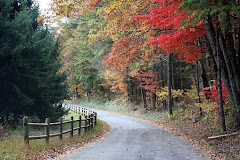This chest is becoming a dusty blue-green!
I'm chalk painting it. Do I know what I'm doing? Almost!
This post is a bit long, but I've learned quite a lot about chalk painting, and wish I'd found it all in one post, therefore this is my attempt to give you more.
Since painting the little chest the post before this told you about, I've done more research about chalk paint, how it should go on, and what to do after painting it and letting the paint dry. And I've begun work on the above pictured chest.
The chest above I bought from a neat and clean antique store. And it looked very clean. But, when I wiped it off with a disinfectant clothes there was yellow grime on the wipes. I thought that was more than enough to do before applying the paint, therefore I went ahead.
Most of the chest the paint covered nicely and it went on quickly. But, some places I knew when I was painting that these may be areas where the paint might come off easily. I was correct.
The You Tube videos and articles I'd read say to use a damp cloth to wipe down the chest after painting. No comments about letting the paint dry but that seemed obvious so I did do that.
Researching again I learned when the paint has dried - at least 4 to 6 hours but preferably 24 hours - the next step is to lightly sand the piece. After trying that and taking off the paint in several places, I went back to the Internet. Finer sand paper is best!
The results of sanding with the fine sandpaper are amazing, because the surface becomes very smooth to the touch. It will change slightly in color as well.
In the case of my chest of drawers, as I've mentioned, some of the paint came off in unattractive splotches, so I've just painted a second coating, making sure to get as thick a coat of paint as possible.
My first coast was also very rough as the with my first experience painting the small cabinet. This sent me once again to the Internet for more information. One person told about some of the things he had done to make the plaster of paris finer grained. The basic idea was to smash it. So, I put mine into a sealed plastic bag, and used a marble rolling pin! It worked well. Next I put the water in a bottle with a lid, added the plaster of pairs I'd smashed, tightened the lid and shook it well. This also helped, so when I mixed in the paint it went on much less rough.
I've just finished my second coat of chalk paint. It's afternoon, so I'll let the paint dry until tomorrow. I've purchased sandpaper #400 which I'll use in the morning. The next step after the light sanding will be applying the clean wax coat with a clean cloth, and wiping off and the excess. After a few hours to allow the wax to dry, the final step will be to buff the surface with a clean cloth.
If my goal was to make the chest appear old and/or shabby chic I would do a bit more sanding and expose the finish underneath on the corners of the drawers etc. and then perhaps use a wax with a dark tent wiping it into spaces that might be darkened by a build up of dust thru the years, and again wiping off the excess.
I'll post pictures of the process and end result after this piece is finished.
For many interesting and informative videos and articles do a search or two. But, as I recently learned, do not expect all the information you need to be in just one video or post!
Continue to learn more about, or even how to do new things. It will keep you feeling younger. It does me!
Prayers for health, comfort and peace.
For many interesting and informative videos and articles do a search or two. But, as I recently learned, do not expect all the information you need to be in just one video or post!
Continue to learn more about, or even how to do new things. It will keep you feeling younger. It does me!
Prayers for health, comfort and peace.

.jpg)









No comments:
Post a Comment
Note: Only a member of this blog may post a comment.